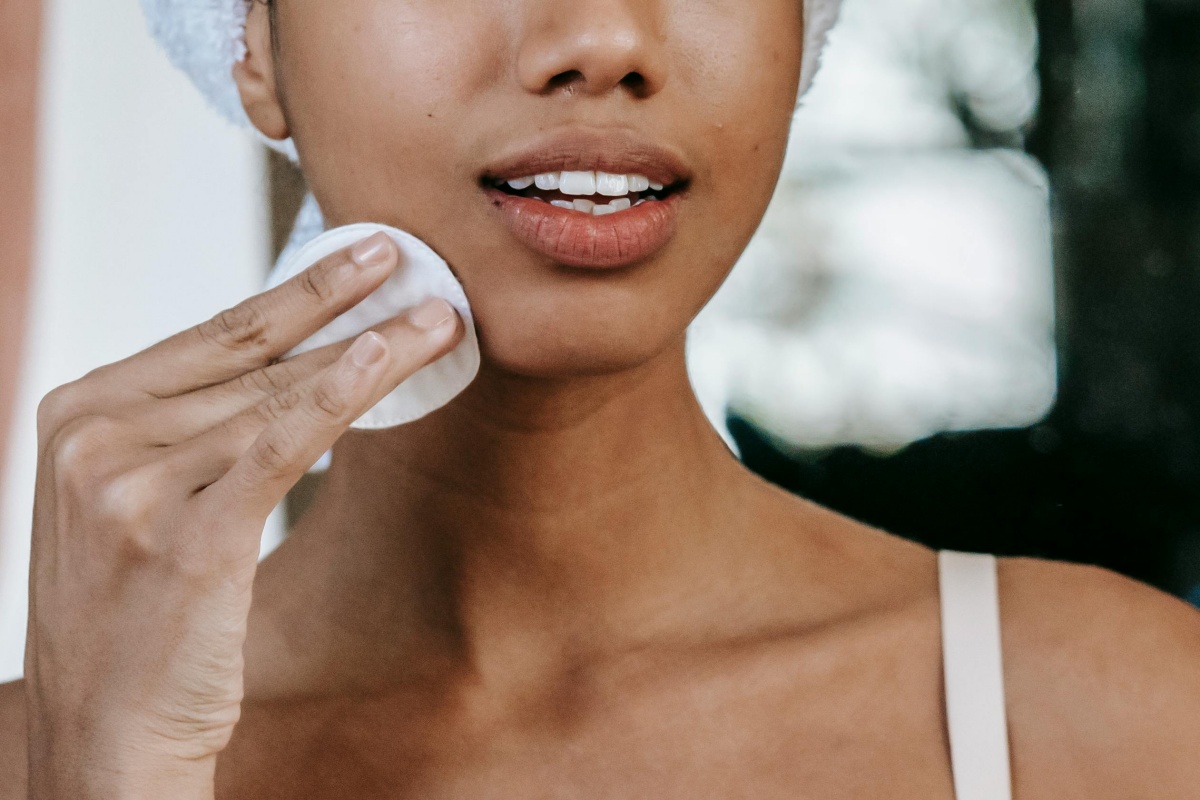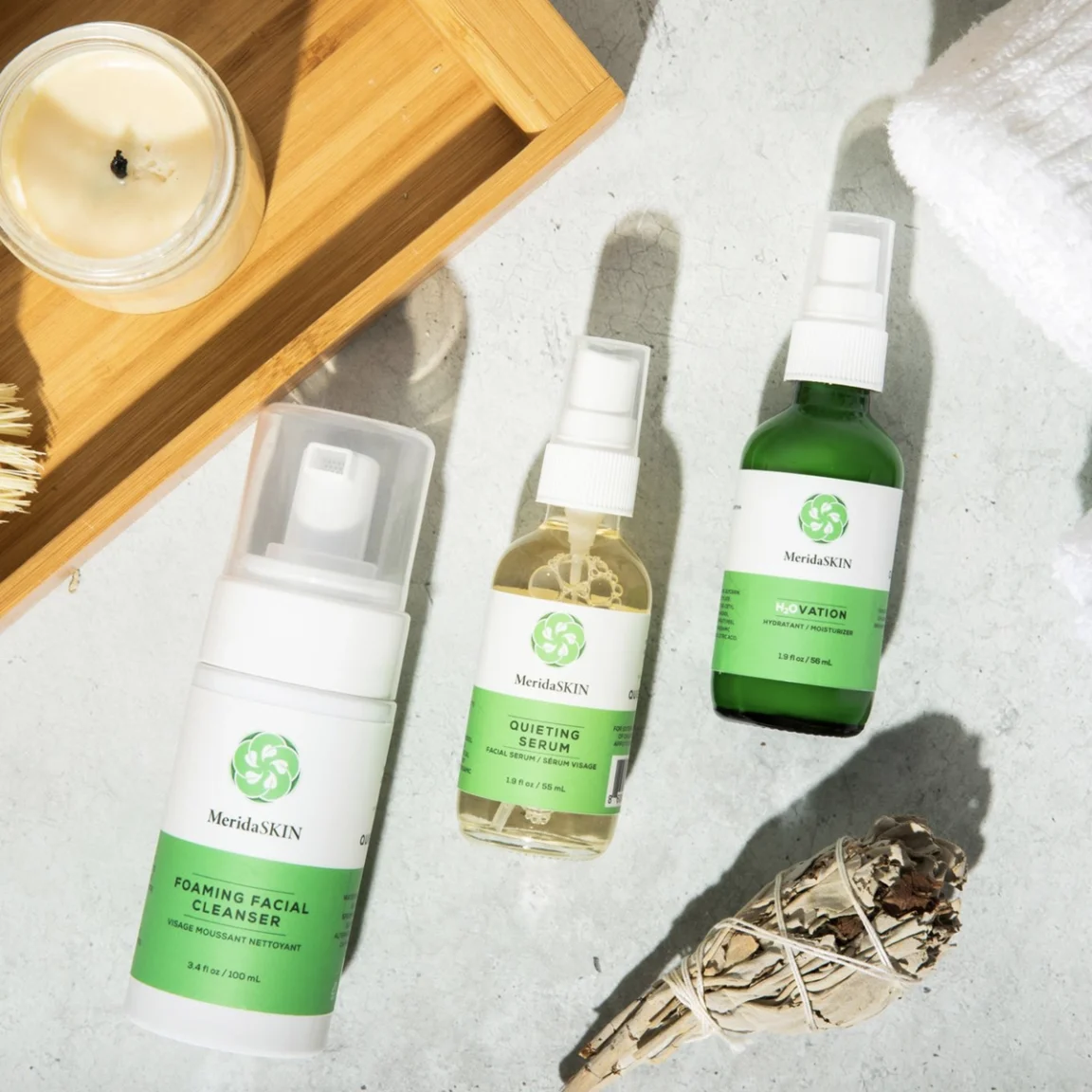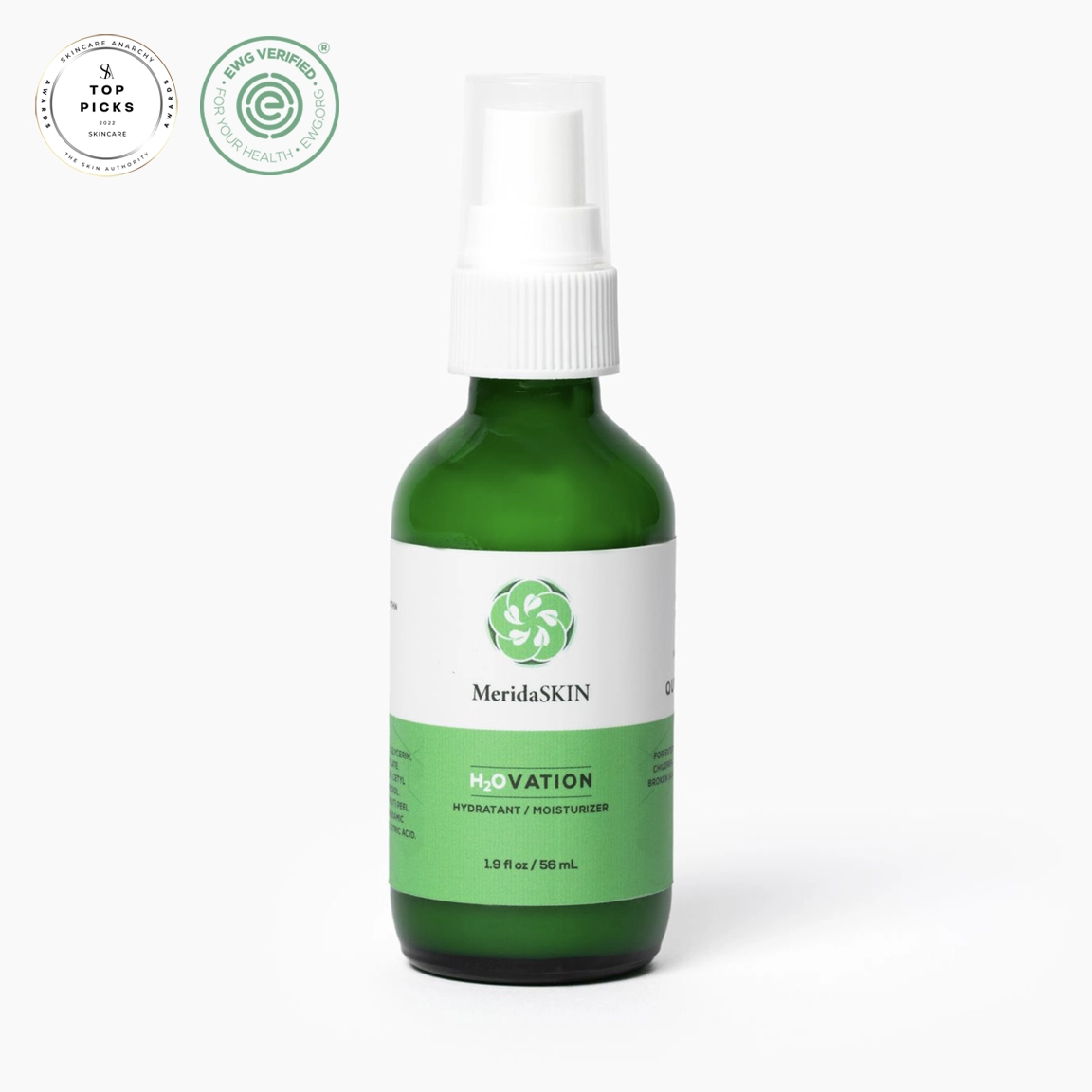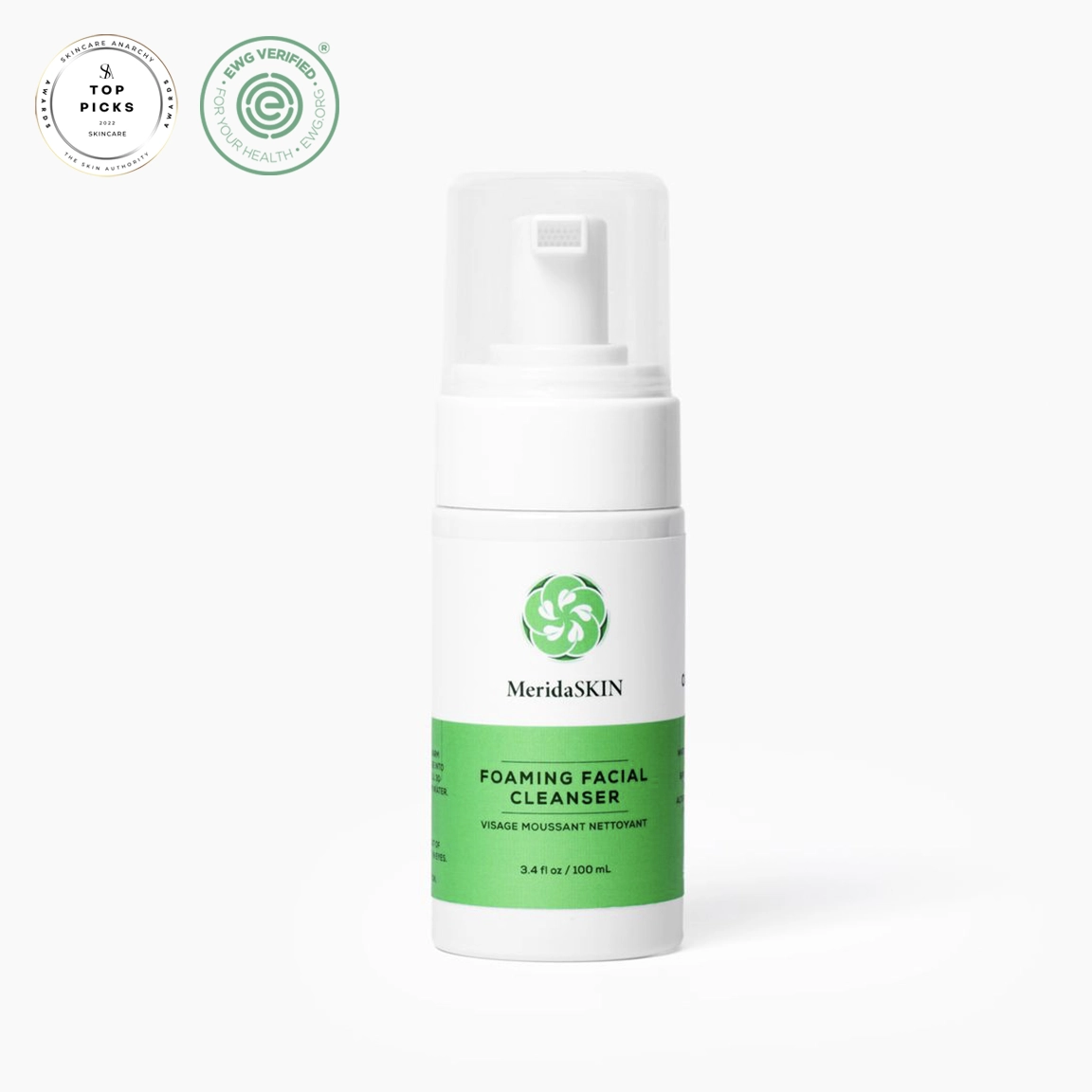If you look on Instagram, a sensitive skincare routine could be 10+ steps. But if you actually have sensitive skin, you know the struggle—one wrong product, too many steps, or even just washing your face too often can lead to irritation, redness, or breakouts. But taking care of your skin doesn’t have to be complicated (or time-consuming). A simple, gentle routine can often be the best way to keep your skin calm, happy, and healthy.
This five-minute skincare routine is designed for everyone—whether you have rosacea, dryness, or easily reactive skin. It’s all about using minimal, non-irritating products that support your skin’s natural barrier without overwhelming it. Because at MeridaSKIN, less really is more.
Ready to streamline your routine and give your skin exactly what it needs? Let’s get started.
-
Merida Essentials: Skincare for Sensitive Skin
$108.00 -
Shea and Squalane Moisturizer for Sensitive Skin
$45.00 — or subscribe and save up to 12% -
Tea Tree Oil Foaming Facial Cleanser
$23.00 — or subscribe and save up to 12%
Step 1: Gentle Cleansing (1 minute)
Even sensitive skin benefits from once or twice daily cleansing, if done carefully. The purpose of cleansing is to remove impurities, such as color cosmetics and environmental pollution, and to remove excess sebum and bacteria. Water alone does not do that very well. A class of cleansing ingredients called surfactants aids removal of these undesirables by weakening their attachment to skin.
Product Considerations
Surfactants
Surfactants vary in terms of their risk to cause irritation, provoke allergy, and damage proteins and lipids associated with skin. Risk also varies with the amount of exposure (i.e., how much is in the product formula, how often it is applied and how long it is in contact with the skin).
So, even a high-risk ingredient may not cause any problem for a user if the exposure is low. Of course, the opposite is also true: a lower-risk ingredient may produce an unpleasant effect if given enough contact time with skin.
All these variables make it challenging to say which surfactants to shop for, but one thing can be said: avoiding the sulfates is worthwhile. The sulfates, which include sodium lauryl sulfate and sodium laureth sulfate, are well known for causing irritation.
When looking for a mild facial cleanser, narrow the field by looking for products that are sulfate-free. Do your face a favor, and make your shampoo sulfate-free as well.
Product pH
Product pH is another factor to consider. Broadly speaking, the natural pH of the outermost skin layer (stratum corneum) is 4.5-5.0. Deeper inside the skin it is around 7.3. Some studies suggest that a neutral pH cleanser with pH around 7 is preferable.
Certainly, skin recovers its normal pH faster after cleansing with neutral or acidic products than it does with alkaline products (which have pH higher than 7). Skin dryness is associated with higher pH. Bar soaps and castile soap have high (alkaline) pH, so may be best to avoid for sensitive and/or dry skin.
How to Apply Your Cleanser
As important as the cleansing product, is how it is applied. Sensitive skin should not be scrubbed. The best way to apply a facial cleanser to sensitive skin is using a gentle massaging motion with bare hands, using lukewarm or barely cool water. Skip the washcloth (and products that have microbeads or grit for mechanical exfoliation). If you take hot showers, opt for cleansing at the basin instead.
Pat the skin dry or allow it to air dry before applying the next product.
Step 2: Toning (30 seconds)
This step is optional. This is where you would use a toner or serum to deliver one or more targeted ingredients for their specific benefits. Examples include aloe vera, vitamin C, glycolic acid, hyaluronic acid, niacinamide, and tea tree oil.
These products should be applied to clean dry fingertips or hands and then patted onto the desired areas of the face. People who favor simple low maintenance routines might opt to skip this step.
Step 3: Let it Soak In (1 minute)
If you apply a serum or toner after cleansing, take a beat to let it soak in and air dry before applying the moisturizer. Serums and toners are usually water-based, while moisturizers are usually emulsions containing a significant amount of lipids as oils and/or butters. Water and oil don’t mix easily. Find something else to do that takes no more than 1-2 minutes and then you’re ready for Step 4.
Step 4: Moisturizing (1 minute)
Daily moisturizing is essential to skin health and appearance. A good moisturizer can replenish some of the normal healthy things that are lost in cleansing and seal cracks between cells in the outermost layers.
Having a nicely sealed skin barrier helps to keep good things in and bad things out. It also promotes a healthy balance of skin micro-organisms. Calm skin is hard to achieve without these things.
Moisturizing for Sensitive Skin
People with easily irritated or blemish-prone skin need to be especially cautious when picking a moisturizer because it is a leave-on product. Leave-on products have prolonged contact time with the skin, which makes them riskier than rinse-off products such as cleansers. Risky ingredients can provoke big unpleasantness in a leave-on formula. There are three main problems that arise:
- Irritation
- Allergy
- Pore-clogging
Never rely on label claims such as hypoallergenic, non-comedogenic, or gentle. While they imply that the manufacturer has tested the products, it does guarantee that they did. Narrow the field of candidates by looking for products that:
- Are fragrance-free and paraben-free.
- Do NOT have highly comedogenic ingredients such as cocoa butter, coconut oil, grape seed oil, myristyl myristate and olive oil. Consider eliminating those from your haircare routine as well.
Beyond that:
- Check the comedogenicity rating of the other ingredients, or check the ingredients against a list of highly comedogenic ingredients (available from various web sources including this list from Acne.org).
- Check the ingredients for irritation and allergy concerns using a resource such as the online EWG SkinDeep Database or the ThinkDirty app.
If that process seems daunting:
- Ask people you trust for recommendations
- Read non-incentivized product reviews
- Try samples from your Dermatologist’s office or retailer.
Discussion forums are another starting point, but sometimes there is a bias or promotional motive that may not be immediately obvious.
As with the other products, moisturizer should be applied with clean, dry hands to recently dry skin. Don’t forget to carry that facial moisturizer down onto your neck!
Step 5: Sun Protection (90 seconds)
Most of the skin’s aging comes from UV exposure. Unfortunately, a high percentage of this photoaging occurs before most people are old enough to know better or do better. But sun protection remains key if you want to minimize skin aging.
Further, exposure to UV rays is a risk factor for all types of skin cancer, for all skin types. Good sun protection habits can decrease photoaging, AND significantly lower the risk of skin cancer.
The best protection is avoidance of UV rays by staying in the shade and donning a broad-brimmed hat, UPF-rated clothing and sunglasses with UVA and UVB protection. Outside those circumstances, apply an adequate amount (it’s more than you think) of SPF30+ to sun-exposed skin at least every two hours (more often if sweating), and after every instance of swimming, bathing or toweling.
How to Choose Your Sunscreen
As with moisturizer, sun protectant is a leave-on product, and so it holds great potential to cause unpleasant skin reactions. The two mineral sunscreen actives, titanium dioxide (TiO2) and zinc oxide (ZnO), are the only sunscreen actives designated by the United States FDA as GRASE (generally regarded as safe and effective).
Of the two, zinc oxide has more broad spectrum protection (good at blocking UVA as well as UVB), and it has the advantage of being soothing to the skin. In light of this, the preferred sun protectant is based on zinc oxide, with or without titanium dioxide.
For sensitive skin sufferers worried about skin reactions, check the active ingredients to be sure there are no other active ingredients apart from TiO2 and ZnO. It is surprisingly difficult to find pure mineral sunscreens without chemical filters included.
Also check the list of inactive ingredients to be sure there are no ingredients ending in the word “glucoside”. The alkyl glucosides, such as coco glucoside, decyl glucoside and lauryl glucoside, are well known for causing skin allergy in leave-on formulas.
Check out our blog post on choosing mineral sunscreen for your face and Instagram reel on how much sunscreen to apply. And don’t forget about your ears!
Simple and Consistent is the Way to Go
If you like simple, it takes 3 minutes or less once or twice a day to get through cleansing, hydrating, and protecting your face. If you enjoy the process or want to pamper yourself, you can certainly add steps and products such as masks, spot treatments, and eye creams.
Just remember, the more products and ingredients you introduce, the more risk of an unpleasant skin reaction. Whatever you do, once you find something that doesn’t offend your sensitive skin, try to use it consistently once or twice daily, and stick with it for at least 4 weeks before you decide if it makes the grade.
Only change one thing at a time if at all possible, to make it easier to identify the culprit of any problems that appear, remembering that reactions can be delayed by days or show up on retrying a product that you had stopped using.
Finally, overall health plays a role in skin health and appearance. If that speaks to you, pay attention to stress reduction, good nutrition, ample hydration, physical activity, and the avoidance of unnecessary drugs and toxins.

Shannon L. Johnson NP-C
Founder & Formulator, MeridaSKIN
Shannon is a nurse practitioner, and much of her career has served vulnerable populations at a community health center. She holds degrees from the University of Pennsylvania and Simmons University, and completed post-graduate training at the University of Massachusetts Boston. She tackled the science of cosmetic formulating to solve her own skin struggle with rosacea. Shannon was born in Oregon, raised in Eastern Massachusetts and has passionate ties to the Pacific Northwest, New England, and the mid-Atlantic. She lives on Boston's North Shore with her husband, two kids and mischievous Wheaten Terrier. She and her family pass the seasons by playing in water (liquid and solid).





Recent Comments